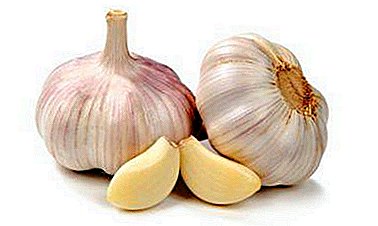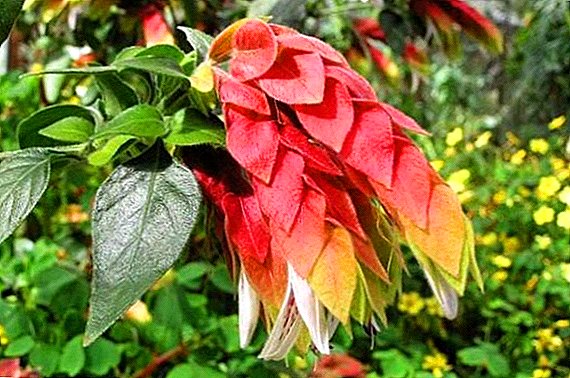 Modern botany knows a lot of bright and unique plants - they can not only successfully fit into the interior of a room or flowerbed, but also become a real decoration of the collection of home flowers.
Modern botany knows a lot of bright and unique plants - they can not only successfully fit into the interior of a room or flowerbed, but also become a real decoration of the collection of home flowers.
One of these plants is the elegant Beloperone, caught in our cold lands from a warm subtropical region. However, plant lovers often do not dare plant this flower, as it is believed that in our northern lands it will not be possible to create proper conditions for it.
And today we will examine in detail what a whiteperon is and whether it is worth growing it on our windowsill.
Botanical description
Beloperone - perennial indoor flowers of the genus of Justice, the family Acanta. The people of the species have a slightly different name: often, many florists call them "room hops" or "crayfish tails." Homeland plants are considered to be tropical and subtropical regions of South America.
Often the form has the form of a half-shrub, but real shrubs are also found. Almost all Acanthus have slightly branched shoots, which are characterized by weak lignification. In most cases, they grow completely naked, but some varieties have weak pubescence.
Did you know? The genus of Justice was named after the Scottish gardener James Justis, who in the XVIII century first revealed one of these flowers.
The height of beloperone is rather modest: an adult plant grows up to 1 m, but in natural conditions there are shrubs and about 1.5 m. The leaflets of the plant are ovate, elliptical, arrow-shaped, they are characterized by distinct wholeness, weak hairiness, and also opposite arrangement on the shoots.
The leaflets of the plant are ovate, elliptical, arrow-shaped, they are characterized by distinct wholeness, weak hairiness, and also opposite arrangement on the shoots.
Acanthus, Tunbergia, Hypoestes, Afelandra, as well as Beloperone, belong to the Acanta family.
The lamina can be up to 15 cm long, but often in an average plant it is within 10 cm. The flowers in beloperone are tubular, solitary, but the most characteristic are spicate inflorescences, symmetrically located on the shoots.
Their shades range from delicate yellow or white to bright pink or red-pink. It is because of this feature that the species falls in love with flower growers around the globe.
But the plant does not give a decorative significance to the plant yet, as extremely bright bracts have the greatest aesthetic value.  They are collected in amazing beauty spike-shaped formations, and some even in lush bunches. The flowering process lasts for 8-10 months a year, after which a period of rest begins.
They are collected in amazing beauty spike-shaped formations, and some even in lush bunches. The flowering process lasts for 8-10 months a year, after which a period of rest begins.
Kinds
Today, about 60 species with various shapes and color shades are usually attributed to this variety of acanthaceae. However, among them, not many have gained special popularity.
The greatest success with both domestic and foreign plant lovers are the following types:
- Drip beloperone - an evergreen plant is from Mexico, so gardeners often call it just “Mexican beauty”. The height of the view reaches about 1 meter, it is also characterized by complex branching.
The leaves have a characteristic ovoid shape, rarely oval. The lamina is narrowed to the petiole, pubescent and above and below. On the shoots the foliage is opposite, the length of each leaflet is within 7 cm.
The flowers are often delicate white shades, they are collected in spike-shaped inflorescences, which reach a length of 20 cm and are located in the axils of pubescent bracts. The color of the bracts predominantly yellow, reddish or green-yellow shades.
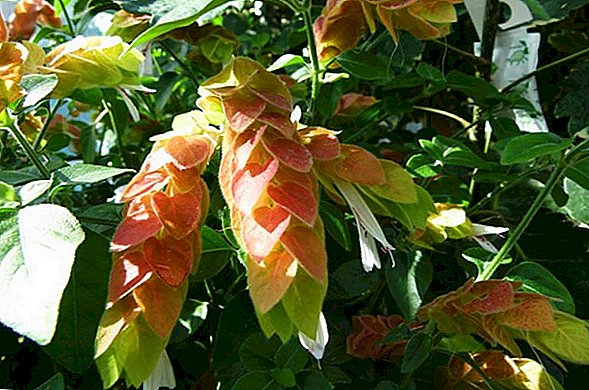
- Drip white operone var. longispica purpurea - Mexican variety flowering shrub, reaching a height of about 80 cm. As described above, this plant is characterized by a rather complex branching, as well as thin and drooping shoots.
In addition to Beloperone, clitoria, alokaziya, tillandsiya, gloriosa, aglaonema, albition, philodendron, dracaena and cordilina also belong to tropical indoor plants.
The leaves have a rounded or ovoid shape, pointed to the top, slightly pubescent. Delicate white flowers develop on bright red bracts. The main difference of a variety from other types of flowers is in almost annual flowering and a short rest period. That is why this white operone is especially valued as an ornamental home plant.

Did you know? Until the beginning of the 20th century, the flower of white operone was practically unknown to the world community. However, everything changed in 1932 after the world famous exhibition in Hanover. The new cultivated plant was so much liked by professional flower growers that in just a few decades it spread throughout the world.
- Plumbagolus beperoperone - semi-shrub whose homeland are considered subtropical forest zones of Brazil. The flower is appreciated due to its graceful form and weakly branched, almost even shoots. They develop the bare leathery leaves of the lanceolate form with a slight pointedness. The plant blooms profusely, during the period of active vegetation, bright red-purple flowers about 5 cm long appear on the shoots. They gather in axillary inflorescences, and the stipules and bracts have a lanceolate form.

Plant Care
Such a representative of a warm climate, like Beloperone, does not require complicated or expensive care, which is why this flower is successfully grown in indoor conditions all over the world. However, in order for this representative of the flora to grow safely and please his flowering over the years, he still needs to create special conditions. We will talk about them further.
Lighting
In order to create the most optimal conditions for the flower, the owner is required to create a bright but diffused light. However, short periods of illumination by direct rays of the sun in the morning and in the evening will not harm it, but on the contrary, they will create an excellent microclimate.
The best pot with such a plant will feel on the west or east side of the apartment, but it can also be successfully grown on window sills from the south and southeast side. In winter, the flower needs an additional light source, so it is imperative that it be sure to organize an artificial luminous backlight. 
Important! Intense solar radiation at noon is extremely harmful for beloperone, so at this time the plant should be protected from direct sunlight as much as possible.
Temperature
In summer and springtime, care should be taken to ensure that the plant is in optimal temperature conditions close to + 20 ° C. In winter and autumn, the temperature should be reduced to + 12-16 ° C. At the same time, its increase should be avoided by more than + 16 ° С, otherwise the flower may lose its foliage.
In addition, sudden changes in heat and cold are extremely harmful for the species, so the flower should be particularly protected from drafts.
Beautifully decorate your home houseplants such as Kufa, Gloriosa, Drimiopsis, Euphorbia, hypoestes, anthurium, zephyranthes, Spathiphyllum, nematanthus, Radermacher, Alokaziya, Guzman, Pentas, Calceolaria, crossandra, Adenium, vrieziya.
The soil
The most optimal substrate for the plant are ready-made flower mixtures. They make it possible to provide the plant organism with all the nutrients necessary for it with quality and for a long time.  In the case of self-preparation of the soil is best suited soil mixture consisting of sheet, sod land, peat and sand in a ratio of 2: 1: 2: 1. In this case, extremely acidic or alkaline soils should be avoided, since the optimum pH value for this medium will be in the range of 5.5-6.5.
In the case of self-preparation of the soil is best suited soil mixture consisting of sheet, sod land, peat and sand in a ratio of 2: 1: 2: 1. In this case, extremely acidic or alkaline soils should be avoided, since the optimum pH value for this medium will be in the range of 5.5-6.5.
We recommend you read on how to independently determine the acidity of the soil.
Watering
In the warm season, the soil should be watered abundantly, but at the same time it should not be allowed to be overwetted, therefore regular watering should be carried out after a light drying of the top of the soil. In case of overflow, the water must be removed immediately, otherwise it may lead to the disease beloperone.
In winter, the amount of water should be reduced, but excessive dryness should be avoided. The ideal moment for moistening the soil is the appearance of a light dry crust on the surface of the substrate.
Important! Watering should be carried out with water at room temperature, otherwise wetting with cold water can lead to illness and even death of a flower.

Humidity
Since Beloperone is a representative of the flora of warm regions, in order for the plant not to dry out, it is necessary to moisten it from time to time with the help of a spray bottle. The procedure can be performed daily, but not more than 1 time per day. Pereuvlazhnyat plant is not worth it, as it can cause fungal invasions of shoots and leaves.
Top dressing
In the period of active growing season from March to September, the white beperone requires additional feeding - this will help to get a healthy, richly flowering plant. In spring and summer, the flower is fed 2 times a month, but when the air temperature is below + 18 ° C, it should be fed once a month.
As an additional source of important elements you can use any fertilizer for flowering species. You can prepare it yourself: for this, 2 g / l of any high-quality mineral fertilizer should be dissolved in water for irrigation. Use the mixture to moisten the soil instead of ordinary tap water. 
Did you know? Described and studied in detail Beloperone was in XIX century thanks to Townsend Brandeggi.
Pruning
Since Beloperone is a fast-growing plant, it requires pruning: it must be cleaned quite often from excess shoots and pinned. Only in this case it will be possible to achieve not only the aesthetic appearance of the crown, but also the systematic appearance of new buds.
In order to give the flower the most favorable view, it is necessary to carefully cut off half the length of the most developed shoots before the beginning of the growing season (in early spring).
Pinch the tops you need in the period of active flowering. At this time, the plant body requires a huge amount of additional nutrients, so it is after cutting that many growers begin to feed the flower.
Video: how to care for beloperon
Transfer
The transplantation process should be carried out in the case when the root system of the flower completely fills the substrate in the pot. Young plants should be transplanted annually, adults - according to the growth rate and intensity. In some cases, under optimal conditions, the flower requires a transplant 2 times per season - you should not be afraid of this.
It is not recommended to plant the white peperone in the largest pot, as the pot volumes should be increased gradually. The ideal option would be the pot, which will be 3-5 cm in diameter more than the previous one.
Important! Beloperone has a rather fragile root system, therefore, when transplanting, the substrate with the plant must be removed as carefully as possible.
The contents withdrawn from the old vase are placed in a new one, after which all the cavities are filled with fresh soil mixture of the composition described above. After the procedure, the plant should be poured abundantly with water: it will best respond to a special nutrient mixture for feeding.
The process of transplanting should be carried out before the beginning of the active growing season, in early March. 
Breeding
Like other indoor plants, whiteperon reproduces fairly well in artificial conditions. In most cases, a new flower is obtained by cutting or growing it from seed. Each of the methods has its own advantages and disadvantages, however, they guarantee almost 100% results. Next, we will focus on each of them in more detail.
Cuttings
The cuttings are carried out in early spring, since the effectiveness of rooting in another period of the year will be much lower.
Cuttings are also propagated by indoor plants such as cross-over, dizygoteka, solanum, columney, callistemon, ripsalis, royal geranium, cordilina, azalea, petunia, sheflera.
The process consists in the following steps:
- From young, non-woody shoots, it is necessary to cut cuttings about 10-15 cm long.
- The cut should be dipped in a special hormonal solution for rooting, which can be purchased at any flower shop.
- The treated cutting should be planted in a small pot with the substrate and watered abundantly.
- The container with the plant is placed in a transparent plastic bag, it is tightly closed, and then placed in a warm corner.
- After 6-8 weeks, the cuttings can be transplanted into a permanent pot.
 Key recommendations for successful grafting:
Key recommendations for successful grafting:- The cutting of the cutting should be carried out at an angle of 45 ° - this makes it possible to create the maximum number of young roots.
- As a soil, you can use both a special flower soil, and a mixture prepared with your own hand according to the method described above.
- During rooting, the plant should be protected from direct sunlight.
- It is necessary to remove the sprouted cuttings from the package gradually, over several days. To do this, you first need to open the package for a few minutes, then gradually increase the time the cutting remains in the open air until it is completely free from the package.
- After transplanting to a permanent place, the cutting must be necessarily fed: in the warm period, feeding is carried out 2 times a month, in the cold - no more than 1.
Important! In order to stimulate the growth of Beloperone, during the period of active vegetation, the flower must be periodically irrigated with warm water. To do this, in the bathroom with the help of a hot shower, you need to create light conditions for the greenhouse, and then pour water over the flower with plenty of warm water for 10 minutes. After that, in a heated bathroom, the plant should be left for 1 hour.
Video: grafting whiteoperone
Seeds
Like grafting, seed reproduction is best done in early spring, but you can get excellent seedlings in room conditions throughout the year.
The process consists of the following steps:
- Prepare the seeds for planting - for this, orange fluff must be carefully removed from the tip of each seed.
- Dip the seed in warm water for 48 hours.
- Prepare a special soil for sowing. To do this, mix coarse sand and soil in a ratio of 2: 1.
- Fill the sowing tank with substrate.
- Spread the seeds evenly over the soil surface and cover with a small amount of substrate.
- Put the pot in a warm place.
After about 4-8 months, the seeds will sprout, after which the sprouts can be transplanted into a permanent pot. 
In order to improve the efficiency of germination, you should use the following recommendations:
- The seeds of the white operon are rather quickly losing their germination, therefore, with their seeding it is not worth delaying.
- The water for soaking the seed should not exceed + 40 ° C, otherwise the seeds may die.
- To increase germination in soaking liquid you need to add 5-10 drops of fertilizer.
- After sowing, at least a small part of the seeds must be in the open air.
- The temperature in the room for germination should not be below + 25 ° C, otherwise the expected efficiency of the process will not be achieved.
Difficulties in growing
In most cases, the cultivation of this flower on its own sill is not a difficult task, as the plant can not be called whimsical.  Often, problems with the flower occur only in the case of improper care for him. As a result, serious damage to the leaves and shoots, up to the death of the plant itself.
Often, problems with the flower occur only in the case of improper care for him. As a result, serious damage to the leaves and shoots, up to the death of the plant itself.
Most often, Beloperone suffers from uneven watering, which leads to either excessive moisture or overdrying of the soil. To avoid this, the flower should be watered in small portions after the appearance of a dry peel on the surface of the substrate.
Also, do not overfeed and flower, as this can lead to a complete lack of flowering and the development of excessive foliage. Therefore, during the period of active vegetation, the number of feedings per month should not exceed 2 procedures, in the winter it should be carried out no more than 1.
In addition, optimal conditions for wintering are vital for the plant, since under too wet and dark conditions, the foliage may turn yellow, and if it is too dry, it will completely disappear. 
Diseases and pests
In most cases, whiteperon refers to a fairly resistant to all kinds of diseases and pests of the species. But in rare cases, this plant can still be affected by some diseases. Most often the plant suffers from:
- aphids - causes the characteristic twisting of the leaves, their almost complete discoloration, as well as the curvature of young, fragile shoots. It is possible to overcome the pest by treating the flower with a soap solution or a pyrethrum solution. In the case of heavy infection, apply "Actellic" or "Phosbecid";
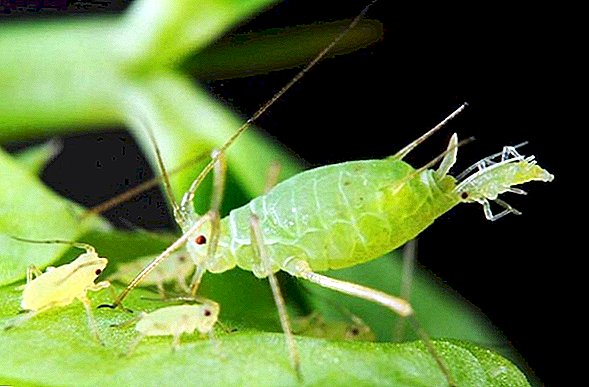
- whiteflies - parasitizes on the surface of leaflets and shoots. The insect can be identified by a characteristic swarm, which rises in case of shaking a flower. Устраняют вредителя при помощи "Актел-лика" или "Децисома";
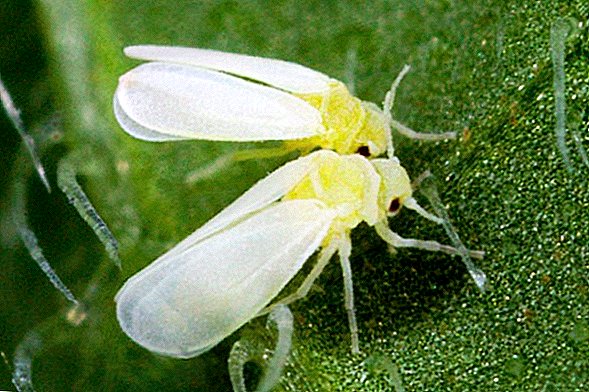
- красного паутинного клеща - насекомое вызывает пожелтение листвы. На нижней части листочков можно заметить характерную серебристую паутину. For prevention, the flower should be periodically washed with water, as well as remove dead leaves. In the event of the appearance of an insect, it can be most effectively overcome with the help of the Actellica solution (15 drops per 1 l of water).
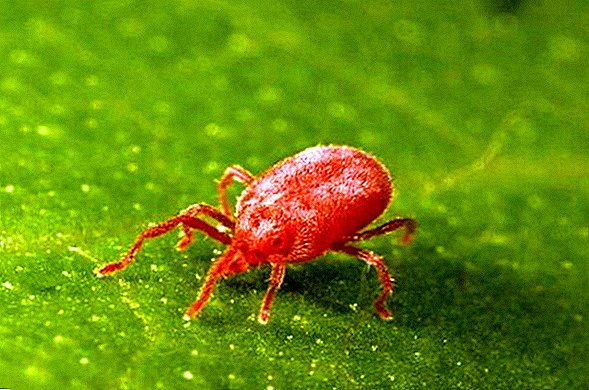
Sometimes during the growing season you can observe rapidly fading foliage or the appearance of brown spots. This process is a consequence of improper care of the flower, namely, non-compliance with the general rules of watering or poor drainage.
With a lack of lighting or excessively high temperature, the shoots of the White Bead are not twisted, and the bracts noticeably fade. Rapidly losing the foliage of the plant will be in the case of insufficient nutrients or too close to the pot.
To eliminate these problems, you must strictly follow the above recommendations for the care of the flower. Beloperone is a rather bright and exotic plant, which was enjoyed by lovers of indoor plants due to its unusual appearance, decorative and long flowering, as well as simplicity in its content.
Network User Reviews
I recently put on the rooting cuttings (whiteperone cut), just in the water, without a package. Already cuttings with roots, rooted no more difficult than in spring and summer. Try not to put on a cold window-sill (so that the water in which the cuttings are not cold).Cherten-ok
//forum.bestflowers.ru/t/beloperone.32236/page-2#post-550207
I love scattered light in the sun leaves turn red and worse flowering. It blooms in the first year, somewhere in a month, pinch the top, which would give side twigs.LERTSYA
//forum.bestflowers.ru/t/beloperone.32236/page-2#post-599309








